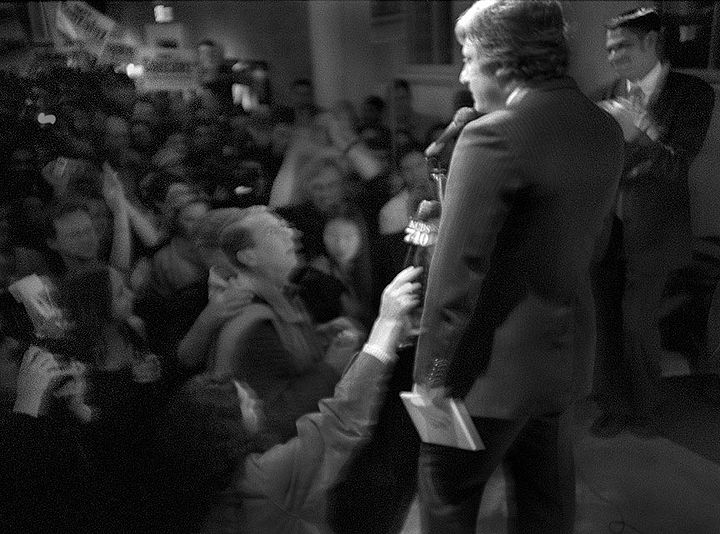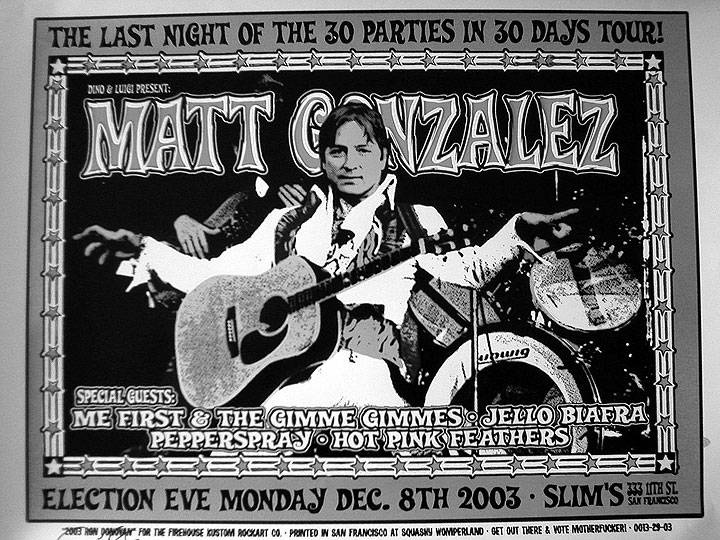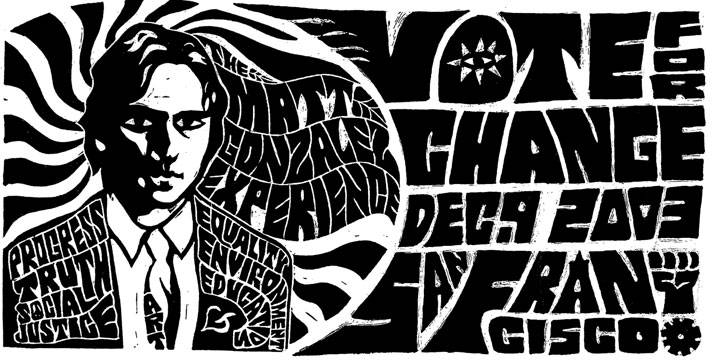Progressive Euphoria and Disappointment In Mayoral Election, 2003
Historical Essay
by Josh Wilson
Matt Gonzalez with Campaign Manager Enrique Pearce at Gallery 111 Minna during the election night party on November 4, 2003 as Gonzalez entered the runoff election.
Photo: Michael Rauner
It almost sparked, with Gonzalez. For a brief, thrilling moment, the fires blazed hot and bright, and all the disparate utopian dreams suddenly seemed possible: car-free Market Street, an end to the scapegoating of the homeless, arts monies for neighborhoods rather than monolithic institutions, community land trusts to keep housing affordable, universal health care, even a tidal-energy project to get us off fossil fuel addiction!
Up till now, the history of this vision—of a radically re-imagined San Francisco, where the humanitarian rather than economic imperative has the upper hand—has largely been a history of stifled prospects, stillborn dreams, and high hopes that have never amounted to much. You can blame the indifference or outright hostility of the status quo, but you’ll be dishonest if you don’t also finger the city’s amazingly brilliant but chronically fragmented political reformers and urban utopians.
The Gonzalez campaign’s unifying power sprang from its affirmation of this vision as not merely beautiful, but inclusive and achievable—a collective, euphoric moment of recognition that, yes, “We can do this!”
There is strength in that moment. It’s the same as the aesthetic fugue of an art lover in the gallery; the same moment as when, at the dance party, the music is so good that no one’s a stranger anymore; the same boundary-erasing emotion that sweeps over the audience at the rock show, when the band goes pyrotechnic, and all mundane troubles of the world—the bills and romantic conflicts and health insurance nightmares—disappear.
It’s the same moment when cruising through Broadway Tunnel among hundreds of other Critical Mass bicyclists, and there are no gunning engines and no choking plumes of exhaust, just bells ringing and people gliding past, hollering, cheering, smiling like an army of blessed liberation, arrived at the nick of time.
Dare I say, it’s even the same moment as that sustained suspension of disbelief that can happen at Burning Man, a week into it, sunburnt and dazzled by the monumental, profound, complex, unhinged expressions of human creativity, so far removed from the everyday nine-to-five grind that it seems like another lifetime.
There’s nothing in that moment except beauty and freedom and potential. And when an entire community shares that moment—when our accepted vision of reality is peeled back and we get a real glimpse of Paradise on Earth—the potential for sociocultural transformation is, by any definition of the word, revolutionary.
And if that moment can last—if it can survive not just the morning after, but the test of time, if it can linger positively in your memory as you slog through the day-to-day continuum of work and debt—then, perhaps, you will see the desire for change cohere into something substantial, and even formidable. And maybe even something that can win.
The danger of a politician harnessing the energy of the euphoric moment—the collective utopian vision—is, of course, demagoguery, and all the bloodletting that historically comes with it.
Totalitarianism and populist fascism aside, the warty second cousin of the demagogue is the charismatic leader. Even given a charismatic leader’s good intentions, the problem with such a person is that when they go away, so does the movement.
In San Francisco, what has come to be termed the “progressive” movement—a grab-bag of Greens, disenchanted Democrats, and miscellaneous leftist politicos—seems, so far, to have lived and died on the ideals, charm, and lover-man good looks of Matt Gonzalez, who lost the election—albeit by a hairsbreadth—and who (then) announced he’s not running for the Board of Supervisors seat he held.
Matt Gonzalez campaign poster, 2003.
So what happens now? Is it all on hold until Matt comes back? Or until the next big political hope comes swinging in on a vine?
We cannot go on like this. We need leaders, but the San Francisco of our dreams cannot live and die on their rise, their fall, or their political moods.
Utopia means “nowhere,” and by necessity that means that our utopian San Francisco cannot be a goal, but a process. We will never get there, but in the process of trying we can make our city a much better place than it ever has been.
The problem is, many of the city’s reform movements in the nineties were notable not only for the grandeur of their vision, but also their frequent failure to move past that initial burst of euphoric, community-building energy.
In 1999, Tom Ammiano gathered around him a giddy swirl of artists, musicians, queers, and plain-old-leftists. He made a hard run at Willie Brown’s office, and he failed, badly. And except for the success of district elections, not very much of Brown’s patronage-driven agenda was derailed at all.
Popular outrage at the dot.com boom’s unprecedented “cultural clearcutting”—as ethnic communities, funky art spaces, and nightclubs alike were uprooted or shuttered by waves of expensive condominium projects colonizing low-rent neighborhoods—amounted to little more than a tempest in a teapot, in the end. Housing is still inhumanely expensive, and Oakland is benefiting greatly from our displaced creative communities. The vanished clubs and venues are gone, forever. The best that we can show for all our efforts is a new entertainment commission—instead of the SFPD—to govern how entertainment venues are permitted in San Francisco.
And the very fact that culture has to be permitted doesn’t indicate much progress at all. If the question of art and culture is, as Situationist grandpappy Guy Debord said, “a question of producing ourselves, not things that enslave us,” then San Francisco really is in deep shit. Our creative underground is going strong, but is still badly bruised by the dot.com boom. I don’t say this as a good-old-days fogey—this is a matter of hard economics. Burning Man now costs a mint to attend, making its message of liberation through participatory creative expression quite inaccessible to broad and important swaths of the population. Extravagant, out-on-the-streets, reality-hacking creativity is tragically rare these days. Brian Goggins’s grinningly skewed “Defenestration” installation—with rubbery, Looney Toons furniture leaping out of the windows of a decaying building on 6th Street and Howard—is steadily decaying, and worse still, seems to have been a one of a kind project, leaving our downtown destitute of anything except self-important corporate architecture. Projects like the 24-Hour Community Spacewalk—which in 1997 and 1998 covered huge segments of the Mission and South of Market with hundreds of multimedia installations, performance events, and participatory art parties—are now utterly absent from our lives. Instead, we have dreary commercial street fairs selling Budweiser for $5. This, from the town that coined the phrase “guerrilla theater” more than thirty years ago!
Consider, also, the transportation reform movement, a think-globally-act-locally phenomenon in San Francisco that is arguably one of the key emergence points. Despite the breathtaking success of Critical Mass as a mass movement that staked out psychological space on urban asphalt for bicyclists, despite the remarkable organizational focus and discipline of the San Francisco Bicycle Coalition, we have not significantly derailed the petro-centric culture of global climate change, oil wars, and pedestrian-unfriendly urban design.
This is big. Lots of people die all around the world because of our oil-dependent society. San Francisco could be leading the world in evolving past this culture of pollution and death, but the high hopes of our collective effort are tragically outweighed by the small scale of our success. We have a few more bike lanes in town, and more bicyclists on the road. Yes. But public transit remains grievously underused and unattractive as a commute option. Rush hour sucks, and is going to suck even more, given time and population growth. There is no car-free city center, following the lauded European model. The San Francisco Chronicle reported in May 2004 that the proposed Mexican and Jewish museums are both going bust on a $43 million parking garage near Yerba Buena Gardens. Car-free Saturdays in Golden Gate Park failed at the ballot box, and now Warren Hellman is ramming through an appalling 800-car underground parking garage in the middle of the park’s previously idyllic Music Concourse. In 1998 the voters called for the removal of the freeway overpass thrust roughly between Valencia, Van Ness, Western Addition, and Upper Market, and somehow no one noticed that there was a new overpass built into the deal—this one double-wide.
These are terrible failures that enable behaviors that reinforce spiraling pollution, social alienation, unsustainable industries, and wage-slave debt financing. Countless millions of dollars are being poured into automobile-friendly projects that rip the guts out of communities and nurture the suicidal imperative to prop up Middle East dictatorships that sell us petroleum for cheap.
Outrage at the system and its consequences brought tens of thousands of people to the streets of San Francisco when George W. Bush invaded Iraq. Where is that energy now? What happened to the anger, the focus, the willingness to change?
What happened is that when those marchers finally wound up at Civic Center, all they found were a bunch of leftover left-wingers unloading decades-old rhetoric about yesterday’s ongoing injustice. And then they went home. And nothing changed. And it was the same old story.
The 2003 mayoral election started out as a tiresome affair featuring the traditional array of flailing leftist Democrats versus a well-funded, heavily favored, Willie Brown–anointed limousine liberal. It was mind-deadeningly ordinary. Into this gaping political void stepped Matt Gonzalez, and he set the city on its ear. The man deserves great credit for bringing plainspoken, straightforward charm to the role of the idealistic, charismatic leader. He wasn’t shrill or bludgeoningly ideological. He was willing to bring fresh ideas to the table, but didn’t promise the moon. His fiscal pragmatism—including skepticism of bond financing—was intriguing.
Gonzalez gave this city’s latent political energy a focus. The chronically disorganized leftists, reformists, and urban utopians were not only motivated, but coordinated. The folks who rallied hardest behind him—who put on the benefit concerts and staffed the phone banks and went door to door—were the seekers who live here for the spirit, the art, the music, the legacy of social innovation. They were, and are, part of a disparate urban Utopian movement—as many rockers as ravers, as many poets as painters, as many hippies as punks, as many proletarians as college kids, as many ecologists and computer programmers.
Coin all the stereotypes of the Left or the underground you like. These diverse groups coalesce around individual expressions of the common experience of euphoric community. And that experience is universally utopian in nature, despite the divergent nature of each subculture’s mode of expression and rituals of participation.
And despite the common experience of euphoric community, the divergence between subcultures had the same inadvertant political effect as any program of “divide and conquer.” Blame identity politics, blame fashion or genre snobbery, blame target-marketed consumerism or isolated creative or political subcultures, but until Gonzalez came along, these urban utopians were simply incapable of coordinated action toward mutual goals, and too individually marginalized to ever be able to match the political focus of San Francisco’s trough-feeding Democratic machine, even considering the American reality of a willfully disenfranchised, cheerlessly apathetic electorate.
The Gonzalez campaign successfully tapped into the euphoric moment, and its extraordinary community-building potential. It almost shattered the cliché of the apathetic electorate, and it almost smashed Democratic Party machine politics into a million pieces. What an upset a win would have been! The news would have been easily as big Gavin Newsom’s savvy playing of the gay marriage card, and far more terrifying to the national Democratic Party leadership than Ralph Nader ever could be.
What happens next, then? Do we sit and wonder what might have been? Do we idly wait for Gonzalez’s next run for office? Do we hang all our hopes for humanitarian, inclusive, non-capital-focused political reform on the peg of one single politician?
If we do, then the urban utopians will remain a marginalized force, relegated to the coffee shops, and to occasional, sentimental reflections in essays about the Bay Area’s colorful cultural history.
In fact, the Bay Area’s greatest cultural achievements have pioneered the reclamation of the channels of democratic discourse. From the first Human Be-In to Critical Mass, from the ecstatic rock show to eclectic underground art spaces, from guerrilla theater to the uncensored, intellectually fertile Internet, San Francisco is an ongoing emergence point for new methods of claiming—or creating—public space for civic engagement.
Gonzalez has shown us that it’s possible to unite the diverse utopian communities in this fair city. Now we must take it to the next level. It’s crucial for progressive reformists to establish new methods of organizing and coordinating. Communities must learn how to identify goals, and agree on methods of achieving them.
Communication, discipline, focus, strategy, and tactics are essential. A disaffected veteran of one notable (and nameless) San Francisco arts collective and facility complained bitterly to me about “cluster” meetings—the co-op committees that set policy there—that lasted for hours, primarily because each participant found it necessary to explore their feelings about the issue of the day, rather than considering potentials and appropriate action.
Similarly, my own experiences at KUSF, a remarkable nonprofit community radio station that has played a crucial role in supporting noncorporate culture and ideas in San Francisco for almost thirty years, have been at once extraordinarily inspiring and enormously frustrating. As a volunteer DJ, producer, and director there since 1994, I have seen waves of staff come and go, and throughout it all the station has at best managed to eke out its own survival from one year to the next. Considering the astonishingly bitter infighting, wailing human tragedy, and monumental bureaucratic indifference that the station’s volunteers endure, it’s a miracle the place has survived this long—and a testament to both the redeeming significance of its cultural mission and the dedication of its individual staff members.
Therein lies the conundrum San Francisco’s utopians must untangle. The strength of their individual visions is enduring. The beauty and promise of their moments of euphoric community is universal. The lack of coordination, the failure to communicate, the fragmentation, and the apathy are epidemic.
Gonzalez showed us that it’s possible to tap into the euphoric community and the utopian impulse, and turn it into a potent political machine. Now San Francisco needs to establish new means and methods for grassroots political engagement. We are the demos, the foundation of democracy, and we must translate our vivid dreams of a more beautiful, humane city into a thriving reality. We don’t need a charismatic leader to make this happen.
The first step has to be the establishment of new, inclusive spaces for civic engagement, encounters with mutually respected rules of participation that eschew vanity, pride, anger, and recrimination. I don’t mean another post-Gonzalez “next steps” forum of irked progressives. I mean a thriving, inclusive, cross-cultural forum for identifying reformist priorities that can be enacted through ballot initiatives. Stuffy and tucked-in they may be, but Robert’s Rules and rotating meeting facilitation may be a useful means of moving the conversation forward. As for a venue—the San Francisco Public Library offers many free meeting spaces around town.
The second step has to be an aggressive run at the on-the-take, money-focused co-option of our electoral system. To truly advance the cause of grassroots, ballot-driven direct democracy, we need to clear the airwaves and the mailboxes of the lies, distortion, and mudslinging of campaign advertising. Political ads should be banned, or rigorously limited by radical “truth in advertising” legislation—and damn the ACLU with their hypocritical support, in the name of free speech, of the “right” of the monied class to access the airwaves. Doing so clearly denies the right of free speech to those who do not have money.
Instead, why not a weekly issues forum and debates hosted by Bay Area broadcast media on a rotating basis? This would be an enormous improvement over deceitful TV campaign ads. Similarly, mailbox-clogging political junk mail could be replaced by a monthly issues bulletin to be mailed to every registered voter in this city, with candidate and issues advertising in the back—the only such advertising to be permitted in a given campaign—covering the costs of publication and delivery. Third Party and no-party participation in debates must be mandated.
The public needs to recognize its power, and stake it out. This can only come from active, vigorous, respectful discourse. It’s not good enough to dream, it’s not good enough to snatch at your glimpses of utopia and your moments of euphoria while you can. And you certainly cannot wait around for Matt Gonzalez to swing in on a vine and pull your ass out of the fire.
Instead, you should be waiting at the doors of City Hall, deciding judiciously whether to permit him entry.
Now that would be quite a city to live in, wouldn’t it?
published originally as "This Magic Moment: Euphoric Community and the Utopian Impulse" in The Political Edge ed. Chris Carlsson (City Lights Foundation: 2004)




